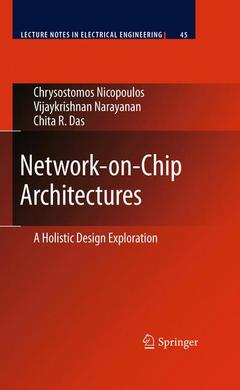Description
Network-on-Chip Architectures, 2010
A Holistic Design Exploration
Lecture Notes in Electrical Engineering Series, Vol. 45
Authors: Nicopoulos Chrysostomos, Narayanan Vijaykrishnan, Das Chita R.
Language: English
Subject for Network-on-Chip Architectures:
Approximative price 168.79 €
Subject to availability at the publisher.
Add to cartPublication date: 10-2009
223 p. · 15.5x23.5 cm · Hardback
Approximative price 147.88 €
In Print (Delivery period: 15 days).
Add to cartPublication date: 03-2012
223 p. · 15.5x23.5 cm · Paperback
Description
/li>Contents
/li>Comment
/li>
A comprehensive study of Network-on-Chip architectures for multi-core chips
Analysis of complex interplay between various design evaluation metrics
Detailed look at both macro- and micro-architectural design issues
Innovative solutions for increased reliability and process variability tolerance




